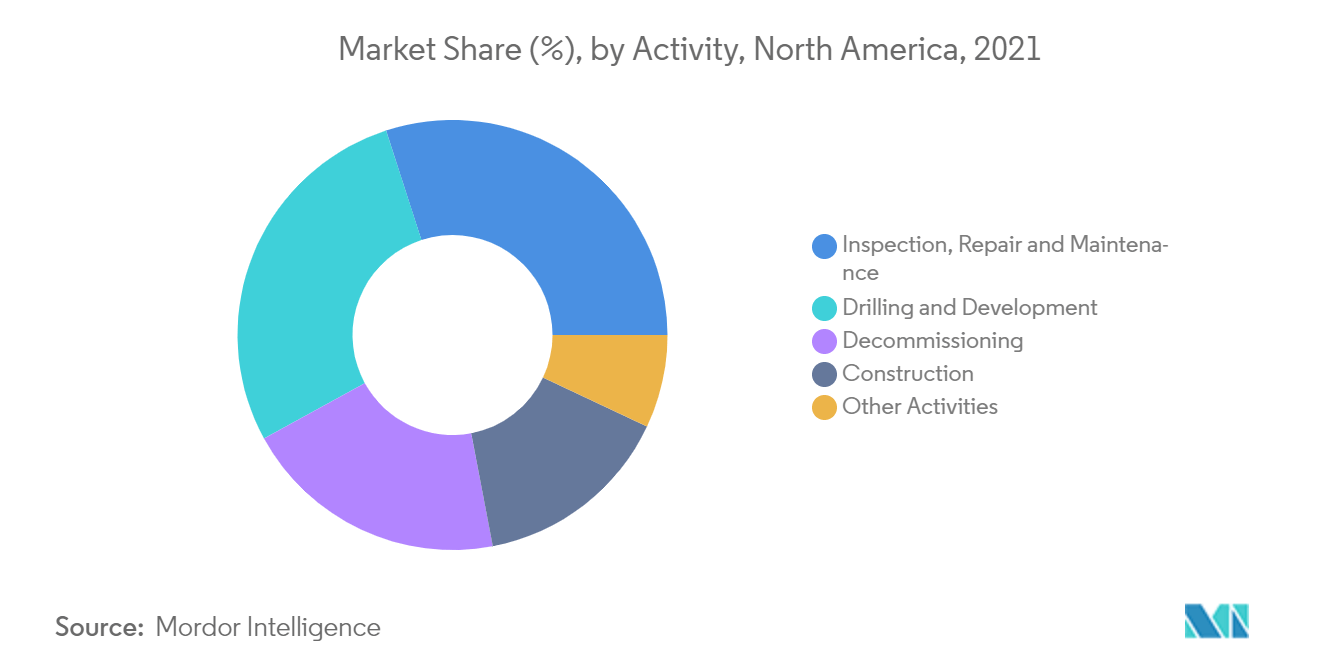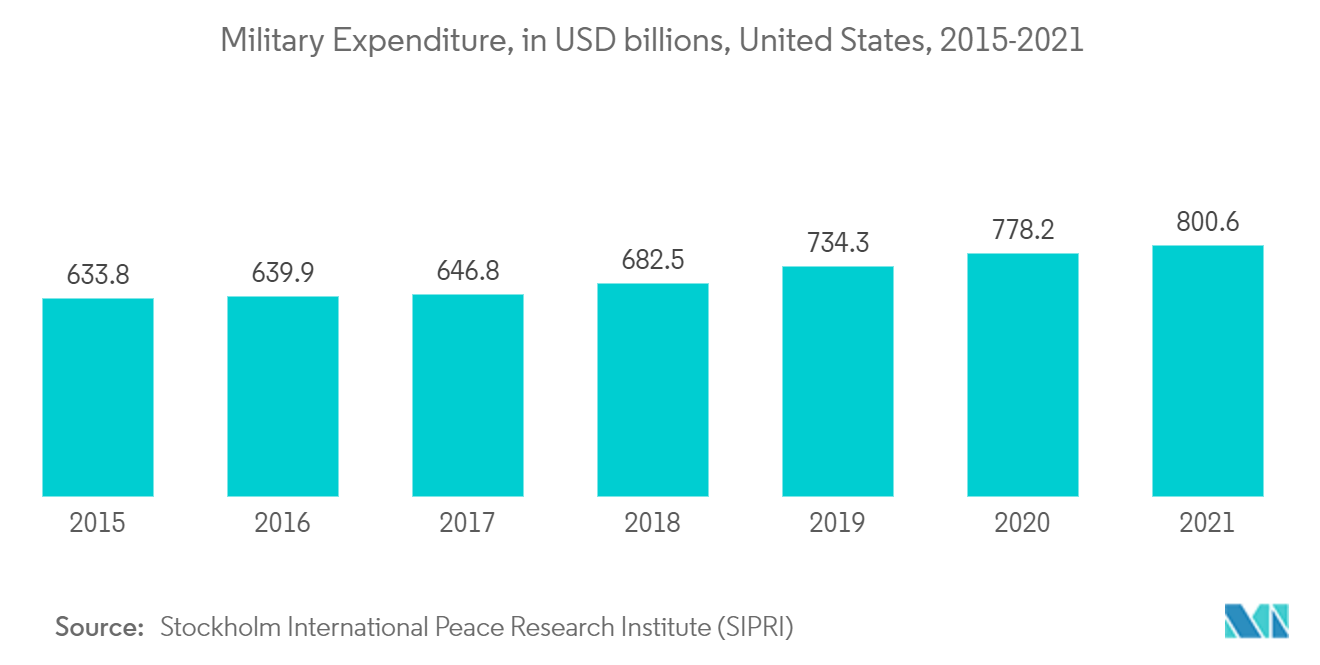Market Trends of North America AUV and ROV Industry
This section covers the major market trends shaping the North America AUV & ROV Market according to our research experts:
Inspection, Repair, and Maintenance Activity to Witness Significant Growth
- The utilization rates for ROV in the oil and gas industry registered a consistent decline during 2014-2017, resulting in declining day rates. Generally, the inspection, repair, and maintenance (IRM) segment is protected from the volatility in oil prices, as these operations are considered necessary and unavoidable. However, the combination of a substantial decline in offshore operations and delay in some of the activities had a strong negative impact on the IRM AUV and ROV services market.
- During the forecast period, the IRM segment is expected to register significant growth, mainly driven by ageing offshore infrastructure, particularly in the North American region which includes United States, and Gulf of Mexico. These ageing infrastructure require more frequent monitoring, along with frequent repair and maintenance activities.
- In the offshore sector, the deepwater and ultra-deepwater activities were hit harder by the decline in oil prices. During the period of downturn, the industry adopted a lower price scenario and responded with project re-engineering, efficiency gains, and better expense management, which resulted in a significant reduction of the total operating cost. All such steps have not only resulted in improving the operational efficiency in the industry but have also reduced the breakeven price of offshore deepwater and ultra-deepwater projects.
- Also, a growing number of companies are offering ROV for inspection, repair, and maintenance (IRM) services for offshore projects. Some of major services being offered by the companies include driverless inspection, pipeline maintenance, subsea structure monitoring, and subsea engineering services. For instance, in March 2021, Houston Mechatronics Inc. announced that it has upgraded its self-developed AUV/ROV transformer, Aquanaut, a multi-purpose subsea robot which can transform an AUV into a tetherless ROV, eliminating the need for large vessels and umbilicals. The new version of this robot, Aquanaut Mk-II, has a deeper depth rating than the first model. It enables collection of data as well as the remote operation of maintenance and repair tasks at a comparatively lower cost.
- Therefore, based on the above-mentioned factors, inspection, repair, and maintenance activity is expected to witness significant growth in the United States during the forecast period.

United States to Dominate the Market
- The United States has invested heavily in defence sector and in the R&D of AUVs and ROVs, other related offshore sectors such oil and gas, shipping and renewable energy have profited immensely from the technological advancements in the market. Due to this, the North American region is at forefront of the AUV and ROV technology, and AUV and ROV manufacturers in the country export their products globally.
- For instance, the United States, as of 2021 spent highest defence budget globally i.e., USD 800.6 billion, an increase of about 26.3% when compared to 2015 value (USD 633.8 billion). This has pioneered the R&D on AUV and ROV vessels. ROVs and AUVs form a critical part of the United States Navy's subsea capabilities. In January 2022, an American F-35C Lightning II crashed in the South China Sea, and the debris sunk to the ocean floor. As the F-35 jet model has cutting-edge technology which would be problematic if acquired by hostile nations, the US Navy started a recovery program. On March 2nd, the wreckage was discovered at a depth of 12,400 ft by an called a CURV-21, which is the Navy's primary deep sea salvage vehicle and can operate to a maximum depth of 20,000 feet.
- As the United States has invested heavily in expanding its oil and gas production capacity, the Gulf of Mexico has become a global hotspot for AUV and ROV demand. As of 2021, the Gulf of Mexico region is responsible for 97% and 15% of the United States' offshore and total hydrocarbon production, respectively. The country has one of the highest global density of offshore rig deployment, and consists of other oil and gas infrastructure such as production and drilling platforms, marine vessels and pipeline networks.
- As ROV and AUV technology has become increasingly affordable, oil and gas producers in the United States have been inclined towards investing in ROV and AUV services for obtaining data and carrying out routine maintenance work on subsea assets and surfaces. Despite the higher upfront cost when compared to diving crews, ROV and AUVs need lesser amount of time to complete the same amount of work, which reduces overall project OPEX.
- Due to this, multiple contracts are routinely dealt out by major oil and gas companies for ROVs and AUV services in the Gulf of Mexico. In January 2021, Oceaneering announced that its subsea segment had won multiple contracts totalling USD 225 million. The contracts were issued by iinternational oil and gas operators and marine construction companies, and the contracted services include remotely operated vehicle (ROV) services delivered from floating drilling rigs and multi-service, subsea intervention, and construction vessels, ROV tooling, survey, positioning, and autonomous underwater vehicle (AUV) services.
- Therefore, based on the above-mentioned factors, United States is expected to dominate the AUV and ROV market in North American region during the forecast period.


